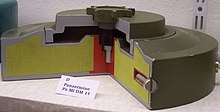Anti-tank mine
Anti-tank mines or anti-tank mines are land mines used to combat armored vehicles . They are much larger and have a greater explosive effect than anti-personnel mines ( anti-personnel mines ).
Anti-tank mine fields are usually secured against evacuation by laying anti-personnel mines at the same time. Anti-tank mines cannot differentiate between military and civilian vehicles and represent a great danger for them. Anti-personnel mines designed for security are also a danger to civilians and unarmored vehicles.
functionality
There are two types: mines that are purely explosive and mines that fire directional charges.
Explosive tank mines are based on the pure explosive effect of several (usually around 5 to 12) kilograms of explosives . Your primary goal is to immobilize the target by breaking the chains. In addition, the shock effect put the crew out of action, at least temporarily, and damage sensitive systems of the tank. Lighter armored vehicles can also be completely destroyed by such mines. To achieve the same effect with heavy tanks, several mines are stacked on top of one another or coupled with a larger charge of explosives. The pressure detonator of the mines only triggers at loads well over 100 kg, so that they are usually not triggered by individuals. However, since a soldier with marching gear and other equipment can weigh more than 100 kg and a running step increases the weight, people can also trigger anti-tank mines in individual cases. These mines are also a danger to civilian vehicles. An example of this type of mine is the Russian PTM-1 .
In addition to explosive tank mines, shaped-charge mines are used to combat heavily armored battle tanks . These can e.g. B. can also be triggered by acoustic or magnetic sensors and then fire a shaped charge sting , rarely also a projectile, into the tub of the tank moving over it. The aim is to penetrate the armor and to detonate the ammunition carried inside the tank through the glowing metal. Variants of this mine type ( off-route mine ) can also be used for distance control. The shaped charge is fired from the mine mounted on a pedestal into the side of the tank, which requires special sensors or target detection. With a further development one tries to take advantage of the relatively weakly armored upper side (roof) of many types of armor. When approaching, a "sublet" is shot a few meters into the air, which then detects the target from there and fires a shaped charge from above. An example of this type of mine is the American M93 Hornet .
In contrast to earlier plate mines and bolt mines, modern directional mines have a much larger area of action. While in earlier mines driving over the detonator was necessary for triggering, modern designs with sensors search for the tank before they actually initiate the anti-tank attack. These heavy mines are laid by hand; other structures can be laid pyrotechnically from the vehicle or from the air.
Tactical use
In addition to their classic use in mine barriers, anti-tank mines are placed on and around drivable slopes in order to stop convoys of armored vehicles. The lead vehicle is first put out of action (immobilized). Subsequent vehicles must now bypass this obstacle, where they may encounter more mines. The normal consequence of this is that a clearing command must be requested in order to create at least a path through the minefield.
During this time, the convoy is an easy target for combat by aircraft, helicopters, or artillery. In a classic ambush to eliminate a smaller convoy with tank destruction troops (with guided or anti-tank weapons ), the last vehicle is often attacked first in order to block the escape route as well.
Such a mine barrier is a certain obstacle even if it is laid above ground, since the convoy is brought to a standstill and crews have to clear the mines. U. The target of an ambush (e.g. by snipers) or by anti-personnel mines can be eliminated.
Types
- Explosive:
- Mk.7 ( Great Britain )
- L9 / L18 "Barmine" (Great Britain)
- TMA-1 to TMA-5 ( Yugoslavia )
- M15, M19 ( USA )
- M21 (directional explosion) (USA)
- Panzermine 60 ( Switzerland )
- M70 / M73 RAAM (USA)
- BLU-91/92 (in CBU-89 Gator cluster bombs) (USA)
- Rifle defense mine DM -11 AP ( Germany ) (no longer part of the Bundeswehr)
- Anti-tank mine DM-21 AT (Germany)
- PTM-1 (Russia)
-
Shaped charge :
- M75 (USA)
- TMRP-6 (Yugoslavia)
- Submunition mine Flach Flach (MIFF) for multi-purpose weapon 1 (Germany): Dropped by a fighter-bomber of the German Air Force
- Anti-tank mine AT2 (Germany): Can be laid with helicopters, rockets and the Bundeswehr's Scorpion mine throwing system
- Anti-tank mine FFV 028 (Sweden), also used by the Bundeswehr as DM 31
- Anti-tank mine 88 (Switzerland)
- PTM-3 (Russia)
-
Anti-tank mines :
- M24, M66 (USA)
- ARGES ( NATO )
- M93 Hornet (USA)
- DM-12 PARM on tripod (Germany)
literature
- Gordon L. Rottman: World War II Infantry Anti-Tank Tactics Osprey Publishing, 2005, page 47, ISBN 978-1-84176-842-7 . (67 pages online PDF)



